Is Your Child on Track? Understanding Key Developmental Milestones

Wondering if your child is developing on schedule? Explore crucial developmental milestones by age and learn how to support your child’s growth effectively.
Introduction
The journey of parenthood is filled with moments of immense joy, wonder, and sometimes, a touch of anxiety. One of the most common questions that echoes in the minds of parents is, "Is my child on track?" Watching a child grow and learn is a remarkable experience, and developmental milestones serve as helpful guides—not rigid timetables—in understanding this incredible journey. This article aims to provide a comprehensive overview of these milestones from birth to five years, celebrate the unique developmental path of each child, and offer guidance for supporting their growth every step of the way. The concern about a child's progress often stems from a deep desire for their well-being, but it can also be influenced by societal expectations. It's important to view milestones as tools for understanding and support, rather than sources of stress or comparison. For more(parents tips ) and insights into Healthy Parenting, explore our resources.
What Are Developmental Milestones and Why Do They Matter?
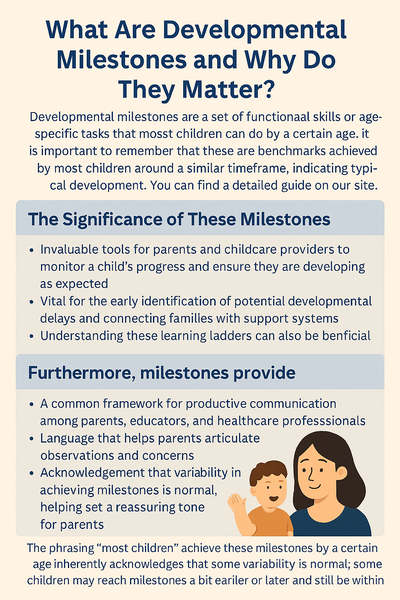
Developmental milestones are a set of functional skills or age-specific tasks that most children can do by a certain age. These behaviors mark stages of typical growth and cover how a child plays, learns, speaks, acts, and moves. The Centers for Disease Control and Prevention (CDC) describes them as "Skills such as taking a first step, smiling for the first time, and waving 'bye-bye'" , while the Cleveland Clinic defines them as “the behaviors that mark stages of typical growth”. It's important to remember that these are benchmarks achieved by most children around a similar timeframe, indicating typical development. You can find a detailed(child developmental milestones guide ) on our site.
The significance of these milestones is multifaceted. They are invaluable tools for parents and childcare providers to monitor a child's progress and ensure they are developing as expected. For professionals, milestones offer guidance on specific areas to focus on for each child in their care. Perhaps most crucially, an awareness of developmental milestones is vital for the early identification of potential developmental delays. This early recognition allows children and their families to be connected with the appropriate resources and support systems. Given that a significant portion of a child's brain development, about 80%, occurs by age three, early support can have a profound impact on a child's future. Understanding these(Learning ladders steps to early education success ) can also be beneficial.
Furthermore, milestones provide a common framework and language for parents, educators, and healthcare professionals. This shared understanding facilitates effective communication about a child's development, enabling productive partnerships and collaborative efforts to ensure the child's best interests are met. When parents are familiar with milestones, they are better equipped to articulate their observations and concerns, leading to more targeted support if needed. The phrasing "most children" achieve these milestones by a certain age inherently acknowledges that some variability is normal; some children may reach milestones a bit earlier or later and still be within a typical range of development. This understanding helps set a reassuring tone as parents navigate their child's unique developmental path.
The Wonderful Tapestry of Growth: Key Areas of Development
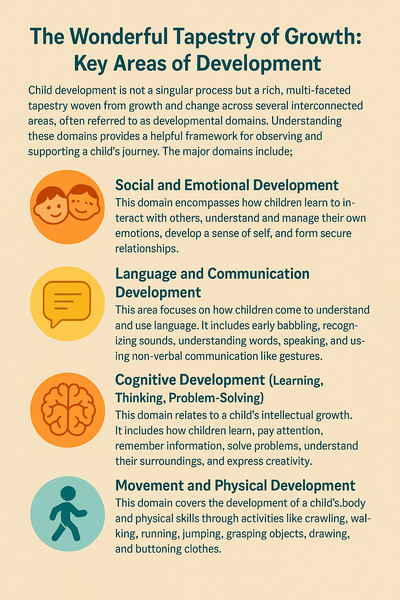
Child development is not a singular process but a rich, multi-faceted tapestry woven from growth and change across several interconnected areas, often referred to as developmental domains. Understanding these domains provides a helpful framework for observing and supporting a child's journey. The major domains include:
- Social and Emotional Development: This domain encompasses how children learn to interact with others, understand and manage their own emotions, develop a sense of self, and form secure relationships. Early signs include a baby calming when spoken to or picked up, and later, a child showing empathy, like comforting a crying friend, or learning to play cooperatively with peers. Learn how to encourage(social skills superstars simple ways to encourage positive interactions ) .
- Language and Communication Development: This area focuses on how children come to understand and use language. It includes early babbling and cooing, recognizing sounds, understanding words, speaking, and using non-verbal communication like gestures to express needs and ideas. Examples range from an infant making sounds back when spoken to, to a toddler following simple directions, to a preschooler engaging in conversations.
- Cognitive Development (Learning, Thinking, Problem-Solving): This domain relates to a child's intellectual growth. It includes how children learn, pay attention, remember information, solve problems, understand their surroundings, and express creativity. Milestones in this area can be as simple as an infant reaching for a desired toy, a toddler copying an adult's actions, or a preschooler playing peek-a-boo, which demonstrates an understanding of object permanence. Discover(unlocking your childs potential fun brainboosting activities for every age ).
- Movement and Physical Development: This domain covers the development of a child's body and physical skills. It's often divided into:
- Gross Motor Skills: These involve the use of large muscles for activities like holding one's head up, sitting, crawling, walking, running, and jumping.
- Fine Motor Skills: These involve the use of small muscles in the hands and fingers for tasks such as grasping objects, drawing, buttoning clothes, and using utensils. Proper Nutrition plays a key role in physical development.
It's crucial to recognize that these domains do not develop in isolation; they are deeply interconnected and influence one another. For instance, pretending to be a superhero during play can be a social-emotional milestone as well as a cognitive one. Similarly, a child's ability to follow directions involves both language/communication skills and cognitive processing. Progress in one area often supports or enables advancements in others. Improved physical abilities, such as crawling or walking, allow a child to explore their environment more actively, which in turn boosts cognitive development by providing new learning experiences. Enhanced language skills naturally lead to richer social interactions, fostering social-emotional growth. Therefore, when considering a child's development, it is beneficial to look at the whole child, appreciating how these different areas of growth weave together to form their unique developmental pattern. Supporting development in one domain can create positive ripple effects across all others.
Your Baby's First Year: A Whirlwind of Discovery (0-12 Months)
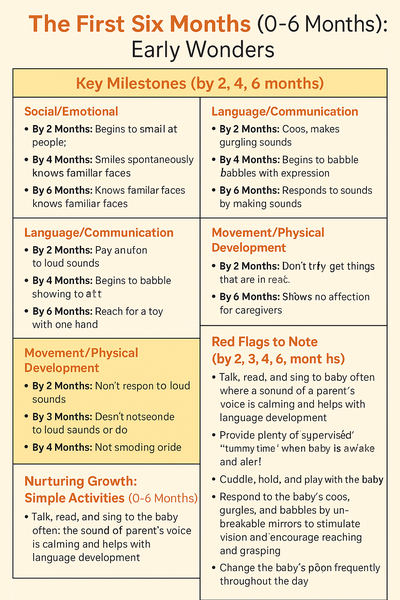
The first year of life is a period of astonishingly rapid growth and change. From a completely dependent newborn, your baby will transform into a little person with a distinct personality, new physical abilities, and emerging ways to communicate and connect. Explore(the ultimate guide to baby sleep from newborn to toddler ) for tips during this crucial year.
A. The First Six Months (0-6 Months): Early Wonders
These initial months are characterized by the awakening of senses and the beginnings of interaction with the world.
- Key Milestones (by 2, 4, 6 months):
- Social/Emotional:
- By 2 Months: Begins to smile at people; briefly calms self (may bring hands to mouth and suck on hand); tries to look at parent. Pays attention to faces.
- By 4 Months: Smiles spontaneously, especially at people; likes to play with people and might cry when playing stops; copies some movements and facial expressions, like smiling or frowning.
- By 6 Months: Knows familiar faces and begins to know if someone is a stranger; likes to play with others, especially parents; responds to other people’s emotions and often seems happy; likes to look at self in a mirror.
- Social/Emotional:
- Red Flags to Note (by 2, 3, 4, 6 months):
- By 2 Months: Doesn't respond to loud sounds; doesn't watch things as they move; doesn't smile at people; can't hold head up when pushing up on tummy.
- By 3 Months: Doesn't notice hands (by 2 mo); cannot support head well; doesn't smile at people; doesn't follow movement by turning head.
- By 4 Months: Doesn't watch things as they move; doesn't smile at people; can't hold head steady; doesn't coo or make sounds; doesn't bring things to mouth; doesn't push down with legs when feet are placed on a firm surface; has trouble moving one or both eyes in all directions.
- By 6 Months: Doesn't try to get things that are in reach; shows no affection for caregivers; doesn't respond to sounds around them; has difficulty getting things to mouth; doesn't make vowel sounds (like “ah,” “eh,” “oh”); doesn't roll over in either direction; doesn't laugh or make squealing sounds; seems very stiff, with tight muscles; seems very floppy, like a rag doll.
- Nurturing Growth: Simple Activities (0-6 Months):
- Talk, read, and sing to the baby often; the sound of a parent's voice is calming and helps with language development.
- Provide plenty of supervised "tummy time" when the baby is awake and alert; this helps build head, neck, and upper body strength.
- Cuddle, hold, and play with the baby; these interactions build a sense of security and love.
- Respond to the baby's coos, gurgles, and babbles by repeating the sounds and adding words; this encourages back-and-forth communication.
- Offer age-appropriate, colorful toys, rattles, or unbreakable mirrors to stimulate vision and encourage reaching and grasping. Find guidance in(the ultimate guide to choosing age appropriate toys for your baby ).
- Change the baby’s position frequently throughout the day (e.g., from back to tummy, holding upright) to encourage different movements and perspectives.
The early months are characterized by the development of sensory responses, such as turning the head towards sounds or following objects with the eyes. These are not just passive reactions; they are the baby's first steps in processing and interacting with their environment, laying the groundwork for more complex cognitive and communication skills. Simple interactions that engage these senses are crucial developmental support. A lack of these early responses is a significant reason to consult a healthcare provider. There is also a remarkably rapid progression from reflexive actions to purposeful movements. For instance, a newborn's hand grasp is largely a reflex , but by four months, a baby is reaching for toys with one hand , and by six months, they can reach to grab a toy they specifically want. This demonstrates swift development in hand-eye coordination and motor planning, which can be supported by providing safe toys within reach.
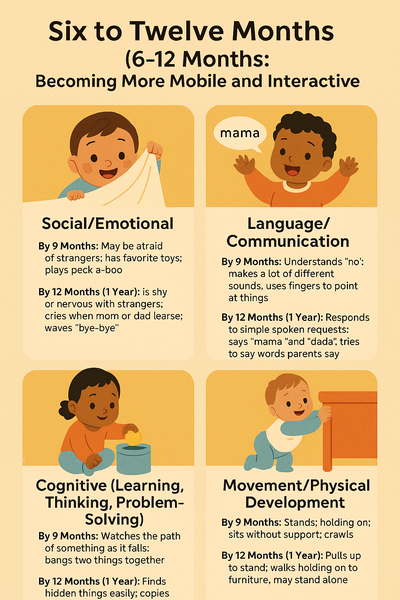
B. Six to Twelve Months (6-12 Months): Becoming More Mobile and Interactive
During this period, babies typically become much more mobile and their personalities begin to shine through more clearly.
- Key Milestones (by 9, 12 months):
- Social/Emotional:
- By 9 Months: May be afraid of strangers (stranger anxiety); may be clingy with familiar adults; has favorite toys; shows several facial expressions, like happy, sad, angry, and surprised; looks when a parent calls their name; reacts when a parent leaves (looks, reaches, or cries); smiles or laughs when playing peek-a-boo.
- By 12 Months (1 Year): Is shy or nervous with strangers; cries when mom or dad leaves (separation anxiety); has favorite things and people; shows fear in some situations; hands a book when wants to hear a story; repeats sounds or actions to get attention; puts out arm or leg to help with dressing; plays games such as “peek-a-boo” and “pat-a-cake”. Waves "bye-bye".
- Social/Emotional:
- Red Flags to Note (by 9, 12 months):
- By 9 Months: Doesn’t bear weight on legs with support; can’t sit even with help; doesn’t babble (“mama”, “baba”, “dada”); doesn’t play any games involving back-and-forth play; doesn’t respond to own name; doesn’t seem to recognize familiar people; doesn’t look where a parent points; doesn’t transfer toys from one hand to the other.
- By 12 Months (1 Year): Doesn’t crawl; can’t stand when supported; doesn’t search for things that are seen hidden; doesn’t say single words like “mama” or “dada”; doesn’t learn gestures like waving or shaking head; doesn’t point to things or pictures; loses skills once had.
- Nurturing Growth: Engaging Activities (6-12 Months):
- Play peek-a-boo and hide-and-seek with toys to reinforce the concept that objects still exist even when not seen (object permanence).
- Read books with the baby every day, pointing to and naming pictures to build vocabulary and a love of reading.
- Provide safe, supervised spaces for the baby to practice crawling, pulling up, and cruising along furniture. For safety tips, see our(safety ) section.
- Encourage self-feeding with soft, easy-to-grasp finger foods to develop fine motor skills and independence.
- Talk to the baby often throughout the day, naming objects, describing actions, and responding to their babbles and gestures.
- Play simple games that involve back-and-forth turn-taking, such as rolling a ball or passing a toy back and forth.
- Offer toys that encourage banging things together, stacking, and putting items into and taking them out of containers.
Significant cognitive and emotional leaps occur during this stage, such as the emergence of object permanence—the understanding that things exist even when they can't be seen. This cognitive shift likely contributes to the development of separation anxiety, as babies now understand a parent is "gone" but still exists elsewhere. Stranger anxiety also reflects an improved ability to differentiate familiar individuals from unfamiliar ones. These are normal and healthy signs of development. Parents can support their child through these phases with consistent routines, reassurance, and playful games like peek-a-boo. The newfound mobility that comes with crawling and pulling to stand dramatically changes the child's world. This independence allows for greater exploration, which in turn fuels cognitive development as they learn about objects, space, and cause-and-effect. However, this also introduces new safety considerations, requiring parents to create "exploration-safe" environments. This phase is crucial for fostering curiosity and independence but demands heightened vigilance.
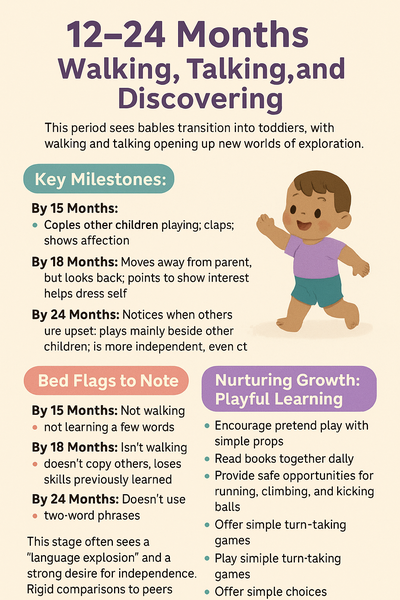
B. 2-3 Years (Including 30-month highlights): Expanding Skills and Personality
As toddlers move towards their third birthday, their skills continue to expand rapidly, and their unique personalities become even more apparent.
- Key Milestones (by 30 months, 3 years):
- Social/Emotional:
- By 30 Months (2.5 Years): Plays next to other children and sometimes plays with them; shows what they can do by saying, “Look at me!”; follows simple routines when told, like helping to pick up toys when parent says, “It’s clean-up time”.
- By 3 Years: Calms down within 10 minutes after a parent leaves (like at a childcare drop off); notices other children and joins them to play; starts to take turns in games; shows affection for friends without prompting; dresses and undresses self (coat, jacket, shirt).
- Social/Emotional:
- Red Flags to Note (by 30 months, 3 years):
- By 30 Months (2.5 Years): If not meeting general 2-year milestones; specifically, if not saying about 50 words or consistently using two-word phrases that include an action word.
- By 3 Years: Falls down a lot or has trouble with stairs; drools or has very unclear speech; can't work simple toys (like peg boards, simple puzzles, turning a handle); doesn't speak in sentences; doesn't understand simple instructions; doesn't make eye contact (note: cultural variations exist, but persistent avoidance is a concern); doesn't play pretend or make-believe; doesn't want to play with other children or with toys; loses skills previously had.
- Nurturing Growth: Fostering Independence (2-3 Years):
- Actively encourage pretend play by providing simple props and joining in their imaginative scenarios. Explore(the art of well being how creative activities boost childrens mental healths ).
- Read together daily. Ask "who," "what," "where," and "why" questions about the story to encourage comprehension and conversation.
- Provide ample opportunities for active physical play: running, jumping, climbing, and riding a tricycle in safe environments.
- Offer art supplies like crayons, washable paint, and playdough for creative expression and to develop fine motor skills. Try some Eco-Friendly Crafts for Kids.
- Speak in longer, more complex sentences and use a rich vocabulary to help expand their language abilities.
- Involve them in simple household chores and encourage self-help skills like dressing and undressing.
- Arrange playdates or group activities to help them practice social skills like sharing, taking turns, and interacting with peers, offering gentle guidance as needed.
A significant social-emotional shift occurs between ages two and three, as children move from primarily playing beside other children (parallel play) to sometimes playing with them around 30 months , and then actively joining others in play and beginning to take turns by age three. This progression indicates developing social awareness, improved communication skills, and an emerging ability to understand and follow basic social rules. Parents can facilitate this growth by creating opportunities for social interaction and gently guiding children in the nuances of cooperative play. Cognitively, the explosion of "why?" questions around age three is a hallmark of this stage. This incessant questioning signifies more than just language development; it reflects a burgeoning curiosity and a deep desire to understand the world, make sense of experiences, and grasp cause-and-effect relationships. While it can be tiring for caregivers, patiently answering these questions—even if the answer is "I don't know, let's find out together"—nurtures critical thinking, a love for learning, and strengthens the parent-child bond through shared discovery.
The Toddler Years: Exploration and Growing Independence (1-3 Years)
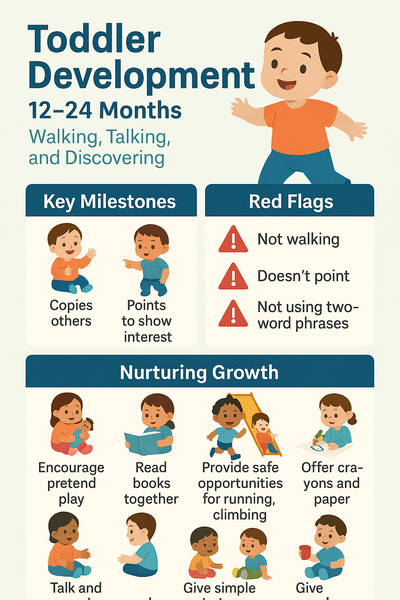
Toddlerhood is a time of incredible transformation, marked by rapidly developing physical skills, language abilities, and a burgeoning sense of self.
A. 12-24 Months (Including 15 & 18-month highlights): Walking, Talking, and Discovering
This period sees babies transition into toddlers, with walking and talking opening up new worlds of exploration.
- Key Milestones (by 15, 18, 24 months):
- Social/Emotional:
- By 15 Months: Copies other children while playing (e.g., taking toys out of a container when another child does); shows an object liked; claps when excited; hugs stuffed dolls or other toys; shows affection (hugs, cuddles, or kisses).
- By 18 Months: Moves away from parent, but looks to make sure parent is close by; points to show something interesting; puts hands out for washing; looks at a few pages in a book with parent; helps dress self by pushing arm through sleeve or lifting foot.
- By 24 Months (2 Years): Notices when others are hurt or upset (e.g., pauses or looks sad when someone is crying); looks at parent's face to see how to react in a new situation; plays mainly beside other children, but is beginning to include other children, such as in chase games. Likes to copy adults and other children; gets excited when with other children; is more independent, even more defiant. Learn about(transforming toddler tantrums how to help your child express anger healthily ).
- Social/Emotional:
- Red Flags to Note (by 15, 18, 24 months):
- By 15 Months: Not walking; not learning new words; doesn't have at least a few single words.
- By 18 Months: Isn't walking; doesn't point to show things to others; doesn't copy others; doesn't know what familiar things are for; doesn't gain new words; doesn't have at least six words; doesn't notice or mind when a caregiver leaves or returns; loses skills previously had.
- By 24 Months (2 Years): Doesn't use two-word phrases (e.g., "drink milk," "want toy"); doesn't know what to do with common things, like a brush, phone, fork, or spoon; doesn't copy actions and words; doesn't follow simple instructions; can't walk steadily; loses skills once had.
- Nurturing Growth: Playful Learning (12-24 Months):
- Encourage pretend play by providing simple props like dolls, toy spoons, old hats, or toy phones, and join in the fun.
- Read books together every day. Ask the child to point to pictures and name familiar objects to build vocabulary.
- Provide plenty of safe opportunities for running, climbing (on age-appropriate structures), and kicking balls. Consider the benefits of(outdoor play child development.
- Offer chunky crayons and paper for scribbling and early drawing experiences.
- Talk to the toddler frequently, naming objects and actions. When they use a single word, expand on it. For example, if the child says "juice," a parent can respond, "You want more apple juice!".
- Play simple turn-taking games like rolling a ball back and forth or taking turns adding a block to a tower.
- Offer simple choices, such as "Do you want the red cup or the blue cup?" to foster a sense of independence and decision-making.
The period between 12 and 24 months often marks the beginning of what is sometimes called the "language explosion." While milestones indicate a progression from a few words around 15-18 months to two-word phrases by 24 months , the exact timing and pace of this explosion can vary significantly from child to child. It's encouraging for parents to see any progress in communication, including gestures and word attempts, and to support this by providing a rich language environment through talking, reading, and singing. While monitoring is important, rigid comparisons to peers should be avoided, and professional advice sought if concerns are significant. This stage also sees a burgeoning desire for independence, often famously expressed as "Me do it!" Toddlers are rapidly gaining new motor skills like walking and self-feeding and cognitive abilities like simple problem-solving. However, their desire to do things independently often outstrips their actual capabilities, and their emotional regulation skills are still quite immature, which can lead to frustration and tantrums. This is a normal and necessary part of development. Parents can support their toddlers by offering manageable choices, practicing patience, setting clear and consistent limits, and teaching simple coping strategies for big feelings.
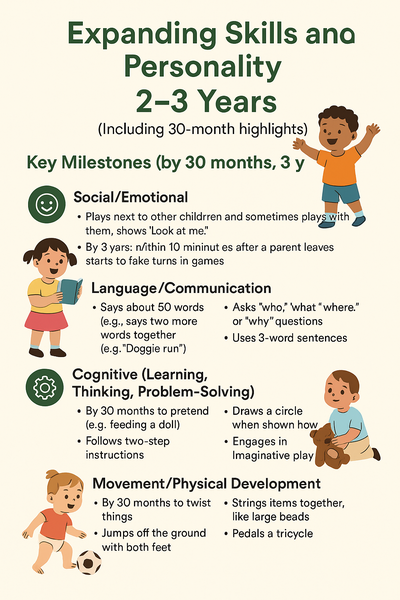
B. 2-3 Years (Including 30-month highlights): Expanding Skills and Personality
As toddlers move towards their third birthday, their skills continue to expand rapidly, and their unique personalities become even more apparent.
- Key Milestones (by 30 months, 3 years):
- Social/Emotional:
- By 30 Months (2.5 Years): Plays next to other children and sometimes plays with them; shows what they can do by saying, “Look at me!”; follows simple routines when told, like helping to pick up toys when parent says, “It’s clean-up time”.
- By 3 Years: Calms down within 10 minutes after a parent leaves (like at a childcare drop off); notices other children and joins them to play; starts to take turns in games; shows affection for friends without prompting; dresses and undresses self (coat, jacket, shirt).
- Language/Communication:
- By 30 Months (2.5 Years): Says about 50 words; says two or more words together, with one action word (e.g., “Doggie run”); names things in a book when parent points and asks, “What is this?”; says words like “I,” “me,” or “we”.
- By 3 Years: Talks with parent in conversation using at least two back-and-forth exchanges; asks “who,” “what,” “where,” or “why” questions (e.g., “Where is mommy/daddy?”); says what action is happening in a picture or book when asked (e.g., “running,” “eating,” or “playing”); says first name when asked; talks well enough for others to understand, most of the time. Uses 3-word sentences.
- Cognitive (Learning, Thinking, Problem-Solving):
- By 30 Months (2.5 Years): Uses things to pretend (e.g., feeding a block to a doll as if it were food); shows simple problem-solving skills (e.g., standing on a small stool to reach something); follows two-step instructions (e.g., “Put the toy down and close the door”); shows knowledge of at least one color (e.g., pointing to a red crayon when asked, “Which one is red?”).
- By 3 Years: Draws a circle when shown how; avoids touching hot objects, like a stove, when warned; understands the concept of "two"; engages in imaginative play; correctly names some colors; follows three-part commands.
- Movement/Physical Development:
- By 30 Months (2.5 Years): Uses hands to twist things, like turning doorknobs or unscrewing lids; takes some clothes off by self, like loose pants or an open jacket; jumps off the ground with both feet; turns book pages, one at a time, when parent reads.
- By 3 Years: Strings items together, like large beads or macaroni; puts on some clothes by self, like loose pants or a jacket; uses a fork; pedals a tricycle; goes upstairs and downstairs without support; kicks ball forward; throws ball overhand.
- Social/Emotional:
- Red Flags to Note (by 30 months, 3 years):
- By 30 Months (2.5 Years): If not meeting general 2-year milestones; specifically, if not saying about 50 words or consistently using two-word phrases that include an action word.
- By 3 Years: Falls down a lot or has trouble with stairs; drools or has very unclear speech; can't work simple toys (like peg boards, simple puzzles, turning a handle); doesn't speak in sentences; doesn't understand simple instructions; doesn't make eye contact (note: cultural variations exist, but persistent avoidance is a concern); doesn't play pretend or make-believe; doesn't want to play with other children or with toys; loses skills previously had.
- Nurturing Growth: Fostering Independence (2-3 Years):
- Actively encourage pretend play by providing simple props and joining in their imaginative scenarios. Explore(the art of well being how creative activities boost childrens mental healths ).
- Read together daily. Ask "who," "what," "where," and "why" questions about the story to encourage comprehension and conversation.
- Provide ample opportunities for active physical play: running, jumping, climbing, and riding a tricycle in safe environments.
- Offer art supplies like crayons, washable paint, and playdough for creative expression and to develop fine motor skills. Try some Eco-Friendly Crafts for Kids.
- Speak in longer, more complex sentences and use a rich vocabulary to help expand their language abilities.
- Involve them in simple household chores and encourage self-help skills like dressing and undressing.
- Arrange playdates or group activities to help them practice social skills like sharing, taking turns, and interacting with peers, offering gentle guidance as needed.
A significant social-emotional shift occurs between ages two and three, as children move from primarily playing beside other children (parallel play) to sometimes playing with them around 30 months , and then actively joining others in play and beginning to take turns by age three. This progression indicates developing social awareness, improved communication skills, and an emerging ability to understand and follow basic social rules. Parents can facilitate this growth by creating opportunities for social interaction and gently guiding children in the nuances of cooperative play. Cognitively, the explosion of "why?" questions around age three is a hallmark of this stage. This incessant questioning signifies more than just language development; it reflects a burgeoning curiosity and a deep desire to understand the world, make sense of experiences, and grasp cause-and-effect relationships. While it can be tiring for caregivers, patiently answering these questions—even if the answer is "I don't know, let's find out together"—nurtures critical thinking, a love for learning, and strengthens the parent-child bond through shared discovery.
Preschool Adventures: Preparing for Bigger Steps (3-5 Years)
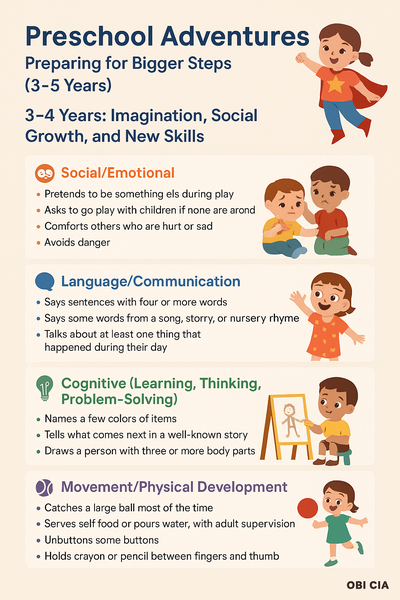
The preschool years are a dynamic period of continued growth, with children becoming more independent, imaginative, and socially adept, laying important foundations for school and beyond. Get insights on(navigating the preschool years key developmental milestones to watch for.
A. 3-4 Years: Imagination, Social Growth, and New Skills
Children in this age group are often bursting with energy, curiosity, and a rich fantasy life.
- Key Milestones (by 4 years):
- Social/Emotional:
- Pretends to be something else during play (e.g., teacher, superhero, dog); asks to go play with children if none are around (e.g., “Can I play with Alex?”); comforts others who are hurt or sad (e.g., hugging a crying friend); avoids danger (e.g., not jumping from tall heights at the playground); likes to be a “helper”; changes behavior based on where they are (e.g., place of worship, library, playground). Cooperates with other children; plays "Mom" or "Dad"; increasingly inventive in fantasy play; negotiates solutions to conflicts.
- Language/Communication:
- Says sentences with four or more words; says some words from a song, story, or nursery rhyme; talks about at least one thing that happened during their day (e.g., “I played soccer”); answers simple questions like “What is a coat for?” or “What is a crayon for?”. Tells stories; uses words that are 75% understandable by strangers.
- Cognitive (Learning, Thinking, Problem-Solving):
- Names a few colors of items; tells what comes next in a well-known story; draws a person with three or more body parts. Understands the concepts of "same" and "different"; understands the concept of counting and may know a few numbers; approaches problems from a single point of view; begins to have a clearer sense of time; follows three-part commands; recalls parts of a story; engages in imaginative play. Learn(how to foster creativity in children 7 expert tips ).
- Movement/Physical Development:
- Catches a large ball most of the time; serves self food or pours water, with adult supervision; unbuttons some buttons; holds crayon or pencil between fingers and thumb (not in a fist). Hops and stands on one foot up to five seconds; goes upstairs and downstairs without support; kicks ball forward; throws ball overhand; catches bounced ball most of the time; moves forward and backward with agility; pedals a tricycle; copies square shapes; uses child-safe scissors; draws circles and squares; begins to copy some capital letters.
- Social/Emotional:
- Red Flags to Note (by 4 years):
- Cannot jump in place; has trouble scribbling; shows no interest in interactive games or pretend play; ignores other children or doesn’t respond to people outside the family; resists dressing, sleeping, and using the toilet; can't retell a favorite story; doesn't follow three-part commands; doesn't understand "same" and "different"; doesn't use "me" and "you" appropriately; speaks unclearly; lashes out without any self-control when angry or upset; cannot copy a circle; doesn’t use sentences of more than three words; loses skills previously had.
- Nurturing Growth: Encouraging Curiosity (3-4 Years):
- Encourage and participate in pretend play with dress-up clothes, household items, and other props to fuel imagination.
- Read together daily, discussing the stories, characters' feelings, and asking "what do you think happens next?" to build comprehension and critical thinking.
- Provide ample opportunities for active physical play: running, jumping, hopping, catching balls, and riding a tricycle.
- Offer art supplies such as crayons, child-safe scissors, paper, and washable paints for drawing, coloring, cutting, and copying simple shapes.
- Talk about colors, shapes, and numbers in everyday contexts, such as counting snacks or identifying shapes in the environment.
- Involve children in simple household chores and encourage self-help skills like dressing and undressing themselves.
- Arrange playdates or group activities to help them practice cooperation, sharing, taking turns, and negotiating solutions to conflicts with peers.
The sophistication of pretend play seen between three and four years old is a remarkable indicator of significant cognitive and social-emotional development. This type of play involves symbolic thinking (a stick can become a magic wand), perspective-taking (imagining what it's like to be a doctor or a firefighter), understanding social roles, and often creating complex narratives and problem-solving within the play scenario. It is far from idle activity; it's a rich learning ground for empathy, creativity, language development, and executive function skills like planning and organizing. Simultaneously, their growing language skills enable more complex social interactions and a better understanding of rules. Clearer communication allows them to express their needs and desires more effectively, understand others' perspectives, negotiate during play, and comprehend rules for games and social situations. This makes it a prime time for parents and educators to explicitly teach social skills, discuss feelings , and explain the reasons behind rules, as children are now more capable of grasping these abstract concepts.
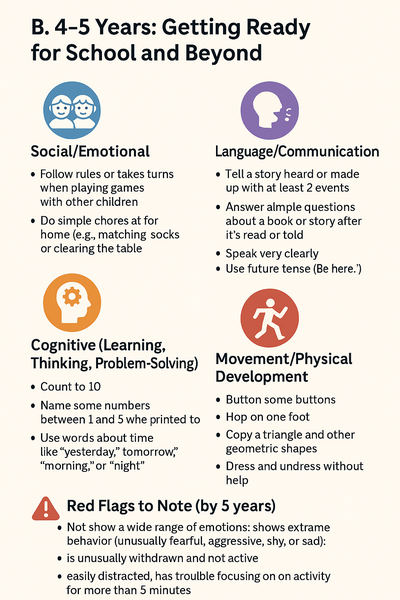
B. 4-5 Years: Getting Ready for School and Beyond
As children approach their fifth birthday, they are typically becoming more confident, capable, and ready for the new challenges and adventures of school.
- Key Milestones (by 5 years):
- Social/Emotional:
- Follows rules or takes turns when playing games with other children; sings, dances, or acts for parent/caregiver; does simple chores at home (e.g., matching socks or clearing the table after eating). Wants to please friends and be like friends; is more likely to agree to rules; shows more independence and may visit a next-door neighbor by themself (with adult supervision); is aware of gender; is sometimes demanding and sometimes very cooperative.
- Language/Communication:
- Tells a story heard or made up with at least two events (e.g., "A cat was stuck in a tree and a firefighter saved it"); answers simple questions about a book or story after it's read or told; keeps a conversation going with more than three back-and-forth exchanges; uses or recognizes simple rhymes (e.g., bat-cat, ball-tall). Speaks very clearly; tells a simple story using full sentences; uses future tense (e.g., “Grandma will be here.”); says name and address. Vocabulary is typically between 1,000 and 2,000 words.
- Cognitive (Learning, Thinking, Problem-Solving):
- Counts to 10; names some numbers between 1 and 5 when pointed to; uses words about time, like “yesterday,” “tomorrow,” “morning,” or “night”; pays attention for 5 to 10 minutes during activities (screen time does not count); writes some letters in their name; names some letters when pointed to. Knows address and phone number; recognizes and can recite the alphabet; understands the difference between fantasy and reality; increased understanding of time; curious about real facts about the world.
- Movement/Physical Development:
- Buttons some buttons; hops on one foot. Hops and may be able to skip; stands on one foot for 10 seconds or longer; can do a somersault; uses a fork and spoon and sometimes a table knife; can use the toilet on their own; swings and climbs; draws a person with six or more body parts; copies a triangle and other geometric shapes; dresses and undresses without help; begins learning to tie shoes.
- Social/Emotional:
- Red Flags to Note (by 5 years):
- Doesn't show a wide range of emotions; shows extreme behavior (unusually fearful, aggressive, shy, or sad); is unusually withdrawn and not active; is easily distracted, has trouble focusing on one activity for more than 5 minutes; doesn't respond to people, or responds only superficially; can't tell what’s real and what’s make-believe; doesn't play a variety of games and activities; can’t give first and last name; doesn't use plurals or past tense properly when speaking; doesn't talk about daily activities or experiences; doesn't draw pictures; can't brush teeth, wash and dry hands, or get undressed without help; loses skills previously had.
- Nurturing Growth: Building Confidence (4-5 Years):
- Encourage participation in rule-based games (board games, card games, Simon Says) to practice turn-taking, following directions, and cooperation.
- Support their storytelling abilities by listening attentively and asking questions; encourage imaginative play and acting out stories.
- Practice counting objects, recognizing letters (especially those in their name), and attempting to write their name or other letters.
- Provide opportunities for more complex physical activities like hopping on one foot, skipping, buttoning clothes, and using scissors for crafts.
- Talk about time concepts in daily routines: days of the week, yesterday, today, tomorrow, morning, afternoon, night.
- Involve them in simple household chores and praise their efforts and contributions to build a sense of responsibility and competence.
- Continue to read together regularly, discussing characters' feelings, motivations, and the plot of the story to enhance comprehension and empathy.
Readiness for formal schooling is not solely about academic knowledge; it encompasses a confluence of skills from all developmental domains. Following rules in a game (social-emotional), telling a coherent story (language), counting a few objects (cognitive), and buttoning a coat (physical/fine motor) are all skills that contribute to a child's ability to thrive in a kindergarten classroom. This includes listening to a teacher, participating in group activities, managing self-care tasks, and engaging with early literacy and numeracy concepts. Parents can support this holistic readiness by fostering these diverse skills through playful interactions and everyday activities, rather than focusing narrowly on academic drills. The increased ability to understand and use abstract concepts, such as time , rhymes , and the distinction between real and make-believe , indicates more sophisticated cognitive processing. These abilities require moving beyond concrete, immediate experiences. For example, recognizing rhymes involves phonological awareness, a critical pre-reading skill. Understanding time involves memory, sequencing, and an appreciation of past and future. Parents can nurture these emerging skills by playing rhyming games, talking about past and future events, and discussing the nuances of stories, all of which build a strong foundation for more complex learning.
When to Seek Guidance: Trusting Your Instincts
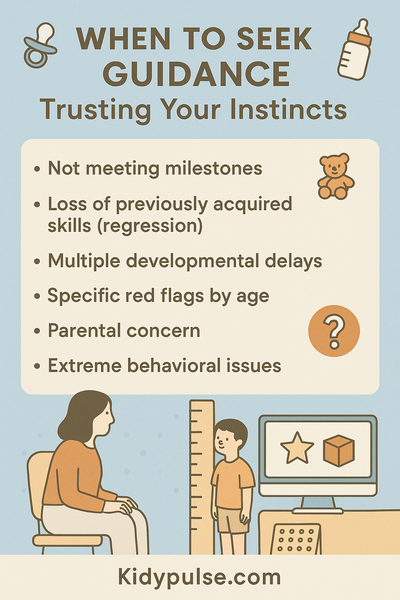
While embracing variability is important, it's equally crucial for parents to trust their instincts and know when to seek professional guidance. The consistent message from child development experts is powerful: "As a parent, you know your child best". If something feels "off" or if there are persistent concerns about a child's development, it is always appropriate to consult a healthcare provider. Check our FAQ for common questions or Contact Us for support.
General indicators that warrant a discussion include:
- Not meeting one or more milestones for their age across any of the developmental domains (social/emotional, language/communication, cognitive, movement/physical).
- Losing skills they once had. This is often referred to as regression and is a significant reason to seek prompt evaluation.
- Significant delays in multiple areas of development. A delay in more than one domain is more likely to be significant than an isolated lag.
- Specific red flags mentioned for various age groups (e.g., not smiling at people by 3 months , not walking by 18 months , or not using two-word phrases by 2 years ).
- Parental concern itself is a valid reason. Even if a child seems to be meeting most milestones, persistent parental worry should be discussed with a doctor.
- Extreme or persistent behavioral issues, such as excessive aggression, prolonged withdrawal, or intense, frequent tantrums that are out of proportion for their age.
It is important to understand the distinction between a child not yet reaching a particular milestone versus losing a skill they previously had. While patience and continued observation are often warranted for slower skill acquisition, particularly if progress is being made in other areas, any loss of skills requires immediate attention from a healthcare professional. Similarly, while an isolated lag in one area might be part of a child's unique developmental trajectory, a pattern of multiple missed milestones or concerns across several domains (e.g., a child who is delayed in walking, talking, and interacting socially) suggests a more pervasive developmental challenge that should be evaluated.
If a growth and development consultation is scheduled, parents can generally expect the specialist to conduct several assessments. These may include:
- Measuring height, weight, and head circumference to track physical growth.
- Assessing gross and fine motor skills.
- Evaluating social interaction abilities and emotional responses.
- Using standardized developmental checklists or screening tools.
- Possibly recommending additional tests, such as hearing or vision screenings, or blood tests, if specific concerns arise.
Trusting parental intuition and acting as an advocate for the child are key. Early detection of any potential issues is crucial for accessing timely support and interventions.
Partnering for Progress: What to Do If You Have Concerns
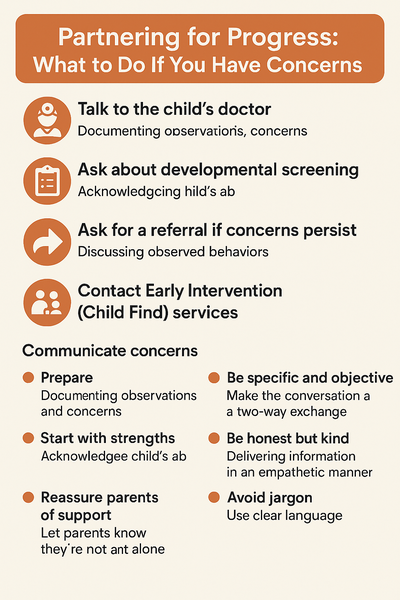
If concerns about a child's development arise, it's important to remember that acting early can make a significant difference. The brain is most adaptable in the early years, a concept known as neuroplasticity, which makes early interventions particularly effective. It is generally easier for a child to learn a skill correctly from the outset than to correct an atypical pattern later.
Here are actionable steps parents can take:
- Talk to the child's doctor: This is usually the first and most important step. Prepare for the appointment by noting specific concerns. Using a milestone checklist, such as those provided by the CDC, can be a helpful tool to organize observations and articulate concerns clearly.
- Ask about developmental screening: The American Academy of Pediatrics recommends regular developmental screenings for all children during well-child visits at 9, 18, and 30 months, and autism-specific screenings at 18 and 24 months, or whenever a parent or provider has a concern. These are standardized tools that provide a more objective look at a child's development.
- Ask for a referral if concerns persist: If, after discussion and initial screening, the parent or the doctor still believes there might be a delay, requesting a referral to a specialist is appropriate. Specialists may include developmental pediatricians, child neurologists, child psychologists, or audiologists and speech-language pathologists, depending on the nature of the concern.
- Contact Early Intervention (Child Find) services: Parents do not need to wait for a doctor's referral or a medical diagnosis to contact their state's public early childhood system. These systems offer free evaluations to determine if a child qualifies for early intervention services.
- For children from birth to 3 years old, this involves contacting the local early intervention system.
- For children 3 years or older, parents can contact any local public elementary school (even if their child does not attend there) and ask to have their child evaluated for preschool special education services.
When communicating concerns, whether as a parent to a professional or as a professional to a parent, certain strategies can make the conversation more productive and less stressful :
- Prepare: Document specific observations and concerns. Using a developmental checklist can provide objective data points.
- Start with strengths: Acknowledge the child's abilities and positive attributes before discussing areas of concern. This sets a supportive tone.
- Be specific and objective: Focus on observed behaviors and missed milestones rather than using labels or attempting to diagnose.
- Listen actively and respectfully: Ensure the conversation is a two-way exchange, valuing the other person's perspective.
- Be honest but kind: Deliver information accurately but in a nonjudgmental and empathetic manner.
- Focus on "ruling out" concerns: Framing the need for evaluation as a way to ensure everything is okay can be less alarming.
- Reassure parents of support: Let parents know that they are not alone and that support is available for them and their child.
- Avoid jargon: Use clear, everyday language. If technical terms are necessary, explain them.
- Do not diagnose (if you are not a qualified medical professional): Diagnosis should only come after a comprehensive evaluation by appropriate specialists.
The process of seeking help can sometimes be multi-layered and may require persistence from parents as they navigate healthcare and educational systems. It is important for parents to feel empowered to advocate for their child throughout this process. Adopting principles of authoritative parenting—which emphasize warmth, clear communication, providing structure (like documented observations), and being responsive—can be very helpful when discussing developmental concerns with professionals and advocating for a child's needs. Learn more about Authoritative vs. Permissive Parenting and(understanding the four parenting styles impacts examples and finding balance.
If you're looking for an engaging toy that encourages both creativity and learning for your little one, the Super Toy Go-Kart Building Set is an excellent choice! Designed for kids 2 years and older, this educational toy lets children build their very own go-kart while improving their fine motor skills and problem-solving abilities.
It’s the perfect balance of fun and education, helping young minds develop a love for building and creating. Plus, it’s a fantastic way to bond with your child as you work together to assemble the toy.
Check it out here: Super Toy Go-Kart Building Set on Amazon.
A Final Thought: Celebrating Every Step of the Journey
Understanding developmental milestones is ultimately about supporting and celebrating a child's unique and wonderful journey of growth. It's not about comparison or pressure, but about providing a nurturing environment where each child can flourish at their own pace. Parents are their child's first and most important teachers, and their biggest advocates. By being observant, informed, and responsive, parents play an irreplaceable role in their child's development. For tips on Cherishing Life's Little Moments and(parenting hacks building strong bonds with your children ), visit our blog.
Enjoy the incredible process of watching your child learn, explore, and discover the world. Recognize that every small step, every new skill mastered, and every expression of their budding personality is an achievement worth celebrating. With the right knowledge and a supportive approach, parents can confidently navigate their child's developmental path, cherishing each moment and knowing when and how to seek guidance if needed. The ultimate goal is to foster a positive, loving parent-child relationship and create an environment where the child feels secure, understood, and encouraged to reach their full potential.
FAQs About Child Developmental Milestones
- Question:
What are developmental milestones in children? - Answer:
Developmental milestones are key physical, cognitive, emotional, and social skills that most children achieve by a certain age. They act as a guideline for tracking your child’s growth and development and include activities like walking, talking, problem-solving, and emotional responses. - Question:
Why is it important to track my child's developmental milestones? - Answer:
Tracking milestones helps parents recognize if a child is developing typically or may need early support. Early detection of delays can lead to timely interventions, which are often more effective during the early years of brain development. - Question:
At what age should my child start speaking? - Answer:
Most children start babbling by 6 months, say simple words like “mama” or “dada” by 12 months, and begin combining words into short phrases around 18–24 months. However, speech development can vary widely among children. - Question:
When should I be concerned about a developmental delay? - Answer:
If your child is consistently missing age-appropriate milestones, such as not walking by 18 months or not forming words by age 2, consult your pediatrician. Each child develops at their own pace, but consistent delays may need evaluation. - Question:
How can I support my child’s development at home? - Answer:
Encourage play-based learning, read regularly, talk and sing with your child, offer age-appropriate challenges, and provide a safe, loving environment. Positive reinforcement and responsive interactions are key to healthy development. - Question:
Do all children reach milestones at the same time? - Answer:
No, children develop at different rates. While milestones provide general guidance, some kids may reach them earlier or later than average. What's most important is steady progress over time. - Question:
How does KidyPulse NutriAI support child development? - Answer:
KidyPulse NutriAI helps parents support child development by offering personalized nutrition plans, developmental insights, and age-specific activity recommendations. It ensures your child receives the right nutrients and mental stimulation for holistic growth.
Sources used in this blog :
Module 2: Understanding Children's Developmental Milestones - CDC
Major Domains in Child Development - Parents
Development & Milestones for Infants (Birth - 12 months) - State of Michigan
Positive Parenting Tips: Infants (0–1 years) | Child Development | CDC
Physical Developmental Milestones: Infants and Toddlers | Virtual Lab School
When Should You Take Your Child for a Growth and Development Consultation?
Variability in Childhood Development | Physical Therapy - Oxford Academic
Variability in Childhood Development - ResearchGate
Developmental Red Flags – When to Refer?
Important Milestones: Your Baby By Nine Months - CDC
Your baby's developmental milestones at 4 months | UNICEF Parenting
Your baby's developmental milestones at 9 months | UNICEF Parenting
Infant development: Milestones from 10 to 12 months - Mayo Clinic
Developmental Milestones: 10-12 Month Baby - Children's Hospital of Orange County
Your toddler's developmental milestones at 2 years | UNICEF
2–3Years - Pathways.org | Track Your Baby's Milestones?
Discussing Developmental Concerns with Parents | Help Me Grow MN
Discussing Developmental Concerns with Parents - Family Connection of South Carolina

Comments
No comments yet. Be the first to leave a comment!